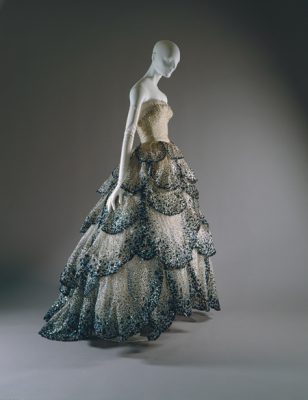I’ve been thinking the last few days about design in fashion, and I think I’ve figured out why I’ve struggled so hard to design artwear using handwoven fabrics. It mostly has to do with focus and focal points. In fashion, most of the time, the focal point is established using texture, motifs, or embellishments – folds of fabric, a brightly colored flower, buttons or epaulets or what have you. None of these showcase handwoven fabrics particularly well – texture obscures the woven pattern (except for fabrics that are naturally textured, like woven shibori with permanent pleats), motifs are hard to make unless you have a jacquard loom, and embellishments distract from the fabric. In addition, handwoven fabric shows off best if there are large expanses of fabric. All these put significant constraints on fashion design, which (I suspect) is one of the reasons handwoven patterns tend to be fairly simple in cut, to allow the fabric to show.
But I want to be more artistic, more “out there” in my fashion designs. So where does that leave me? Not sure yet – I definitely need to ponder on the underlying design issues some more.
Meanwhile, however, here is another tempting design, this one “Junon” from Christian Dior’s 1949-50 collection (photo courtesy Metropolitan Museum of Art, for non-commercial use in concordance with site’s terms and conditions):

This dress is wonderful because the petals look like feathers – wouldn’t it be delightful to do the petals in phoenix fabric, with a gradual color gradation from top to bottom? Or “layering” the petals, alternating dark phoenix and light phoenix. I’m really excited by this possibility, far more excited than by the cloak, which (design-wise) is boring and flat.
Of course, the downside is that doing a variant of this design would involve weaving approximately one bazillion yards (that’s a technical term 🙂 ) of super-fine fabric, and even then I’m not sure it would be floaty enough. (The Dior dress is made of beaded net, so the original fabric starts out nearly weightless.) Because of the expanses of fabric required, I don’t think I’d be able to complete it in time for Convergence next year. But…wouldn’t it be fabulous?
I definitely want to explore this idea further, and will try doing some fashion sketches and draping some muslins to see how it would look in different color schemes, and different petal shape constructions. I’m thinking that if I make the petal shapes ruffles, I could get that beautiful color gradation across the bottom edges of the petals by using a painted warp. And that would open up all sorts of other possibilities…
I like this the best, so far, of all the ideas I’ve “tried on” – going to run up to Sharon’s in a week or two to see what she thinks of its feasibility. Meanwhile, time for sketches and ruffle play.

I love that dress! Is there a way to weave net? Or do a simple gauze weave! That might work and be light enough. There is a dress in the ROM collection (Helen Forsythe Bell) was the bride, but I don’t remember the accession # – it’s in Keep Me Warm One Night – that uses a gauze weave that might work.